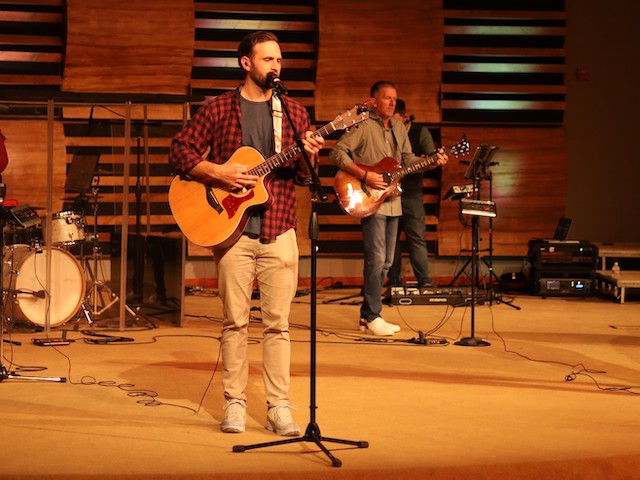When Matt Bennett arrived at Church at the Crossing in Aledo, Texas to be their new worship pastor, he knew he had some work to do. Built in 2004, only minimal maintenance had been done on the AVL systems, No one knew how to operate the lighting boards (yes, two of them), and there were audio dead spots everywhere. Add on an acoustically challenging curved wall and the Covid 19 streaming scramble…you get the idea.

Matt had previously worked at Highland Baptist Church in Waco where Lucid had just completed a lighting overhaul, so as soon as he had the chance he reached out and asked if we could help, of course we said yes! We were able to do a site visit when Joe was in the area, so we got a good idea of what the challenges were. We also knew that the budget was going to be limited. So, we worked together to establish some priorities.
The audio system was original to the building, but the speakers worked and they had spare amplifiers on hand. One item that would cause a huge headache if it failed was the audio DSP, so we planned for a Q-Sys DSP and system tuning. Broadcast audio was being mixed in another room, but on a cascaded console with just an ipad and headphones. This worked but we took note to see if we could configure a better solution…
Another major paint point was the stage infrastructure. There were floor boxes with XLR inputs across the stage and TRS Patchbays in the rack, but there was almost no labeling on any of it. After 16 years there were a few bad lines too. Things were to the point where no one dared re-patch any input because of the unknowns. We planned to trace and label all of the stage inputs, and make repairs.
There was a huge wooden set on stage to cover the curved wall. However it cut off more than 30% of the stage and turned into a hiding place for piles of stuff. Matt wanted a fresh look and really wanted to have full use of the stage. So, some sort of acoustic treatment that would look good as a stage set was high on the list. This gets its own write-up one day soon.
Like most churches, Crossing added a live streaming setup during Covid that included a couple of PTZ cameras, broadcast audio, and Wirecast. However, it was a challenge to get the live stream to look decent, let alone consistent from week to week. A third camera along with better lighting and calibration went into the plan.
And that brings us to the lighting system. There were plenty of fixtures, however several needed new lamps and the focus didn’t really correspond with how they were using the stage. Thankfully most of the fixtures were on a catwalk, so a new stage plot and some time to focus the lights would go a long way. As mentioned earlier, there were multiple lighting consoles and no one knew how to use them, so we planned for a new Vista EX control surface with a touchscreen for easy graphical programming.
Altogether, this optimization plan allowed us to address the major pain points in each system while making strategic updates and staying within a budget that church leadership felt comfortable with.
Once everything was approved and equipment received, we spent one week on site with Matt and his team. We worked through each system strategically starting with audio and acoustics, then we tackled the lighting and finished with video.
Wednesday night rehearsal sounded great, we were all surprised by how much life was still left in the old speakers. We set up a matrix mix on the Front of house console for broadcast. This helped free up a volunteer for each weekend and streamlined their audio workflow. Win-win. Repairing the old patch bays proved to be quite difficult, but we got it done and the client can move musicians with ease!
The new lighting plot only required about a third of the fixtures that were available, while effectively lighting the whole worship team front line, back line, choir section, and front steps. The volunteers dove right into the new vista set up and quickly learned how to update the cue list from week to week.
We added the third PTZ camera, white balanced and calibrated exposure settings with the lighting cues, and saved some presets in each camera for easy recall. For a single operator to handle 3 cameras, graphics, and monitor the live stream is a lot, but this set up sure gets the job done!
At the end of the day we love these optimization projects, and we think our clients do too. We are able to help make the most of all the existing equipment investments and help set the team up for success moving forward. I think Matt would agree.
